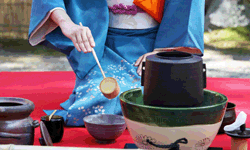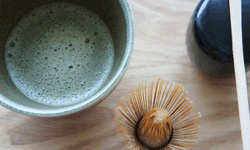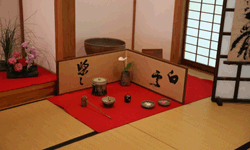


【Outline of Japanese Tea Ceremony】
The Japanese tea ceremony, also called “Chanoyu” or “Sado” is the art and ritual of serving special powdered green tea (matcha). Matcha is made by adding hot water to powered green tea leaves and rapidly beating it with a bamboo whisk
and served to guests at the tea ceremony. It is a Japanese cultural activity involving the ceremonial preparation and presentation of matcha.
It originated in the monasteries of Zen Buddhism around in the 12th century.
Later the Japanese tea ceremony had been perfected by Sen-no-Rikyu and became popular first among Samurai in the 16th century and then rich merchants in Edo era (1603 – 1868). As was introduced in Japanese Garden site, the tea
ceremony is deeply related with Zen Buddhism in which people try to attain enlightenment even in harsh natural environments. So, a tea garden is often called “Roji (outdoors)”, usually having only natural trees, stepping stones
to the tea house and “Tsukubai” or a wash basin to purify hands and mouth along with his or her spirit before the ceremony.
Today, it is regarded as a form of artistic discipline for the cultivation of mental composure
and elegant manners, which reminds people of the spirit of Zen Buddhism.
In the tea ceremony, you could enjoy not only the taste of matcha, but also the calm and silent atmosphere with appreciating various Japanese culture; such as simple flower arrangement, a hanging scroll sometimes with
a calligraphy or India ink painting, and various utensils such as a Chashaku (tea scoop), the Cha-ire tea caddy (oftene lacquered one), fukusa (silk cloth) to clean the whisk and caddy, a bamboo whisk, Chawan (tea bowl of pottery
or porcelain) , Furo (portable brazier) etc.
You can also enjoy an artistic Japanese confectionery (“Higashi” dried one or “Nerikiri” white sweet bean paste one), which is served with matcha. Especially “Nerikiri” is
too beautiful to eat in the shape of a seasonal beautiful flower or any other seasonal object such as moon. As such, the tea ceremony has played an important role to have improved Japanese culture by accommodating the above garden,
arts, utensils and sweets in the tea ceremony.